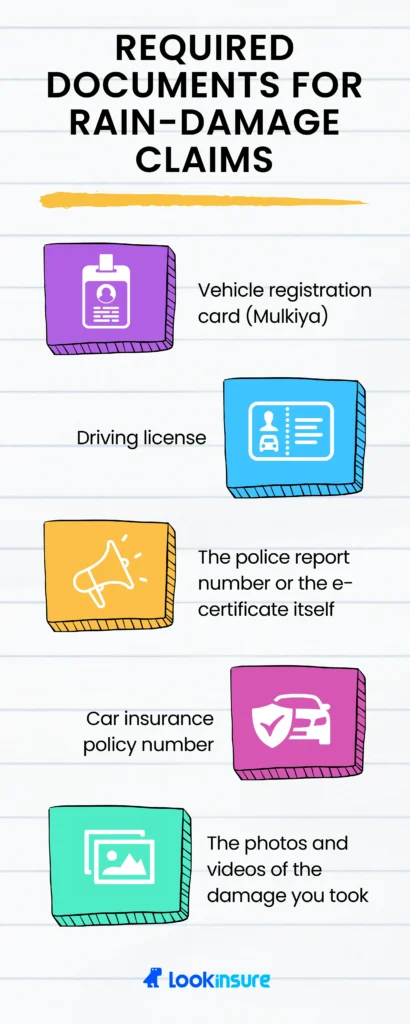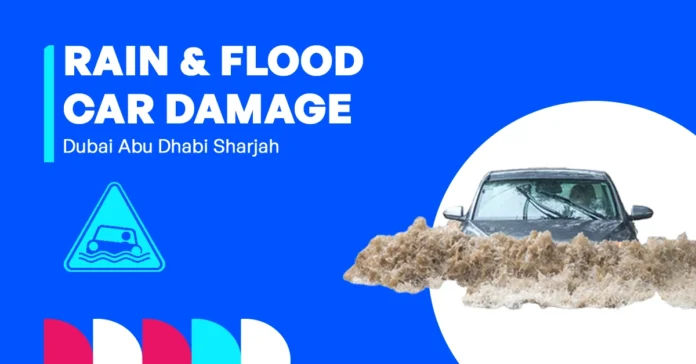The 2024 floods in Dubai, Sharjah, and Abu Dhabi were a powerful reminder of how quickly things can change. For many drivers, this meant filing a claim on their insurance for rain damaged vehicles for the first time. But no all drivers were lucky enough to have motor insurance for rain & flood damages.
If you like to prepare yourself for another unfortunate event like this, then keep reading as this guide will explain the steps from the flooding accident until you get your car repaired or replaced. The most important thing is to act carefully to keep yourself safe and to make sure your claim for car insurance for flood damage goes through without any problems.
Immediate Actions After Flood Damage
When your car is involved in flooding, having the right motor insurance for rain & flood damages becomes important. It’s the difference between a straightforward insurance process and an expensive repair bill. Like other insurance policies, they have specific claim conditions. So, following the next few steps correctly is key to claiming insurance for rain damaged vehicles in UAE effortlessly.
Ensure Your Safety
Before you think about the car, check if everyone is okay and not injured. If the water is still rising or the current is strong, the best thing to do is to leave the car and move to higher ground. Your safety is always the number one priority. It can be tempting to try and push the car out of the water, but it may not be worth the risk.
Do Not Start the Engine
Even if the car looks okay, do not try to start a flooded engine. If water has gotten into the engine, turning it on can cause something called ‘hydrolock’. This is when water, which doesn’t compress like air, gets trapped inside the engine cylinders.
When you try to start the car, the pistons try to compress the water and cause catastrophic damage, like bending or breaking connecting rods and destroying the engine block. An engine repair like that is incredibly expensive. Starting the car can give your insurance company a reason to deny your claim for motor insurance for rain & flood damages, as they might argue you intentionally made the damage worse.
Document the Damage
Once it is safe, grab your phone and start documenting everything. This visual evidence is going to be very important for your car insurance for flood damage claims. Take clear, wide-angle photos and videos that show:
- The overall situation and the car’s position.
- The water level, both inside and outside the car. Try to capture a shot that shows how deep the water was by using a landmark like a curb.
- The exterior of the car from all angles.
- The interior, showing water levels on the seats, dashboard, and floor. Take a picture of the odometer and the infotainment screen if they are damaged.
Contact the Police
In the UAE, you must report any accident, including flood damage, to the police. This is a mandatory step for filing a car insurance for flood damage claims. You can call the non-emergency police line or file a report directly through the official police app for your emirate. Without this report, your insurance for rain damaged vehicles cannot process your claim.
Get a Police Certificate
After you file the report, you need to get an official document from the police. This is called a “To Whom It May Concern” certificate. It’s an official piece of paper that states your car was damaged due to the weather.
You can apply for this e-certificate online via the Dubai Police app or their website, the Sharjah Police app, TAMM, or the Abu Dhabi Police app. This is a key document your insurer will ask for when you file for motor insurance for rain & flood damages.
Request Roadside Assistance
Now that you have your police report, it’s time to move the car. Do not try to drive it. Contact your insurance provider’s hotline and ask for roadside assistance and towing. They will arrange to have your car towed to an authorized garage or inspection center.
If you can’t get through to your insurer, you can call a private towing service, but keep the receipt so you can check if your policy for car insurance for flood damage reimburses you for it.
Here is a quick summary of these first steps to claim insurance for rain damaged vehicles:
| Step | Action | Recommended Timing |
| 1 | Ensure the safety of all passengers | Immediately |
| 2 | Do not start the engine | Immediately |
| 3 | Document the damage with photos/videos | As soon as it is safe |
| 4 | Contact the police and file a report | Within 24 hours |
| 5 | Obtain the police certificate | As soon as possible after reporting |
| 6 | Request roadside assistance for towing | After getting the police report |
| 7 | Contact your insurer to file the claim | Within 24-48 hours |
Insurance and Claims
This is where having the right insurance for rain damaged vehicles pays off. The process can be frustrating, but if you follow the steps, it is easily manageable.
Contact Your Insurance Company
You should contact your insurance company as soon as you have the police certificate. Call the claims department hotline or file an online claims request. Be ready to provide your policy number and explain the situation clearly. They will open a claim file for you and guide you on what they need next. The key here is to be quick; don’t wait for days. Then your motor insurance for rain & flood damages coverage officially goes to work.
Follow the Claims Process
The insurance for rain damaged vehicles provider will need these documents to proceed:
- Vehicle registration card (Mulkiya).
- Driving license.
- The police report number or the e-certificate itself.
- Car insurance policy number.
- The photos and videos of the damage you took.

Having these ready will speed up your claim for motor insurance for rain & flood damages.
Have the Car Inspected
The insurance company will send a surveyor to the garage where your car was towed. Their job is to inspect the vehicle and determine the extent and cost of the damage. They will check everything from the engine and electronics to the interior. Their report decides whether the company will approve your car insurance for flood damage, claim for repairs, or declare the car a total loss.
Post-Claim Steps
Once your motor insurance for rain & flood damages claim is approved, the repair work begins. But even after the main repairs, there are a couple of things you need to handle. These steps are often overseen by the workshop recommended by your insurance for rain damaged vehicles provider.
Dry the Interior Completely
This is about more than just a clean smell. A professional garage will completely strip the interior—removing seats, carpets, and trim—to dry everything out thoroughly. If any moisture is trapped, it will lead to mold growth. This isn’t just a bad smell; it can cause serious health issues and ruin your car’s interior. Make sure this deep cleaning and drying is part of the repair job covered by your car insurance for flood damage. In this case, the approved insurance garage list can help you choose a reliable place.
Inspect Electrical Systems
Modern cars are packed with electronics. Water can be a silent killer for these systems, causing problems that might not show up for weeks or months. A qualified mechanic needs to check every electrical component. This includes the engine control unit, airbag sensors, power windows, stereo, and all the wiring.
They need to clean, dry, and test everything to ensure your car is not just dry, but also safe to drive. A comprehensive car insurance for flood damage policy should cover this safety check. This is a non-negotiable part of restoring a car covered by insurance for rain damaged vehicles.
Conclusion
Dealing with a flood-damaged car is stressful. But if you remember the key steps—put safety first, never start a flooded engine, document everything, get a police report, and work closely with your insurance provider—you can get through it. This entire process underscores the value of having comprehensive insurance for rain damaged vehicles.
The right policy for motor insurance for rain & flood damages is your safety net, but it only works if you follow the rules. Stay calm, be methodical, and you will be able to handle this situation and get back on the road.
Frequently Answered Questions
1. How do I handle my car after it gets flooded in Dubai?
The first thing is to ensure you and your passengers are safe. DO NOT start the car. Take pictures and videos of the damage and the water level. Report the incident to the police and get a “To Whom It May Concern” certificate. Call your insurance company to arrange for towing and start the claims process for your motor insurance for rain & flood damages.
2. Can starting a flooded car affect my insurance claim?
Yes. Starting a flooded engine can cause severe internal damage that is expensive to fix. Many insurance companies will see this as you increase the damage on purpose, and may deny part or all of your insurance for rain damaged vehicles claim.
3. How do I get a “To Whom It May Concern” police certificate in the UAE?
You can get this e-certificate online for a small fee. For Dubai, use the Dubai Police app or website. For Sharjah, use the Sharjah Police app, and for Abu Dhabi, use the TAMM service. Look for the service to request a “To Whom It May Concern” certificate for a traffic accident or vehicle incident, and follow the instructions.
4. What documents are required to file an insurance claim for flood damage?
You need the following documents for motor insurance for rain & flood damages claims:
Registration card (mulkiya).
Driver’s license.
Insurance policy number.
Police report or certificate.
Photos and videos of the damage.
5. How do I clean a flood-damaged car and check its electrical systems?
A good garage will remove all the interior parts, like seats and carpet, to dry and prevent mold. For the electrical systems, a qualified mechanic must inspect, clean, and test all electronic modules, sensors, and wiring looms to make sure they are safe. This should be coordinated through your car insurance for flood damage providers.



